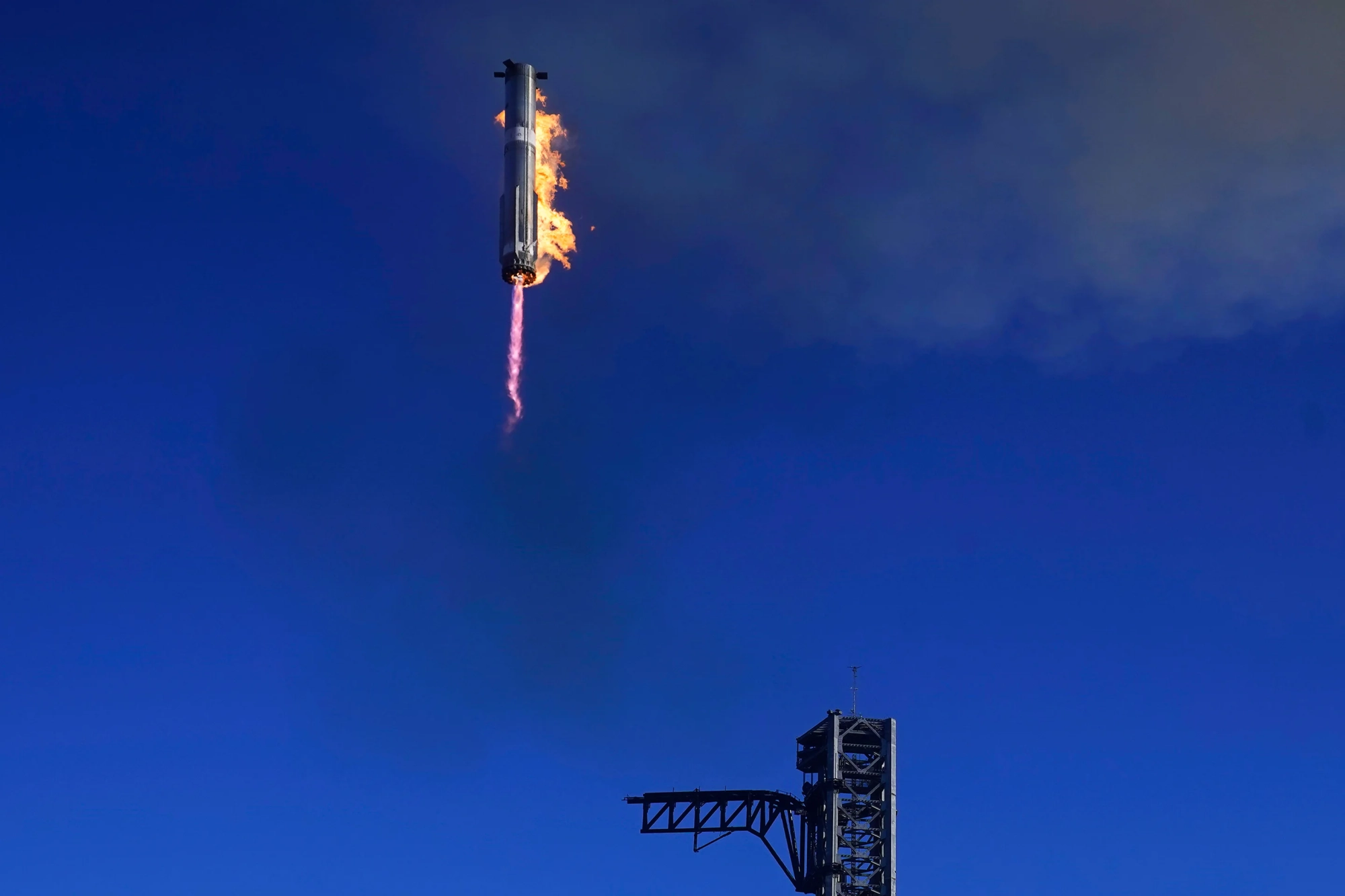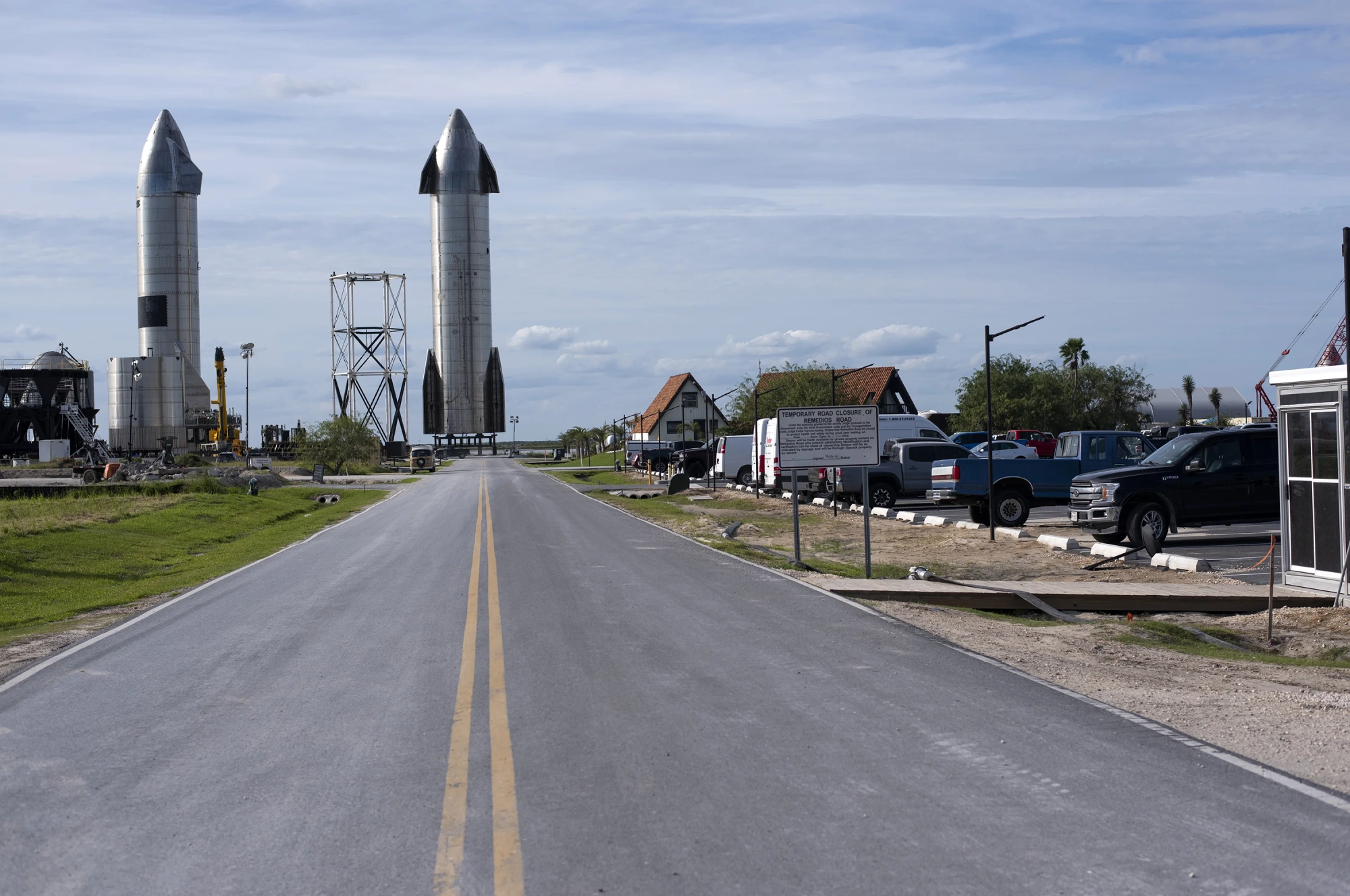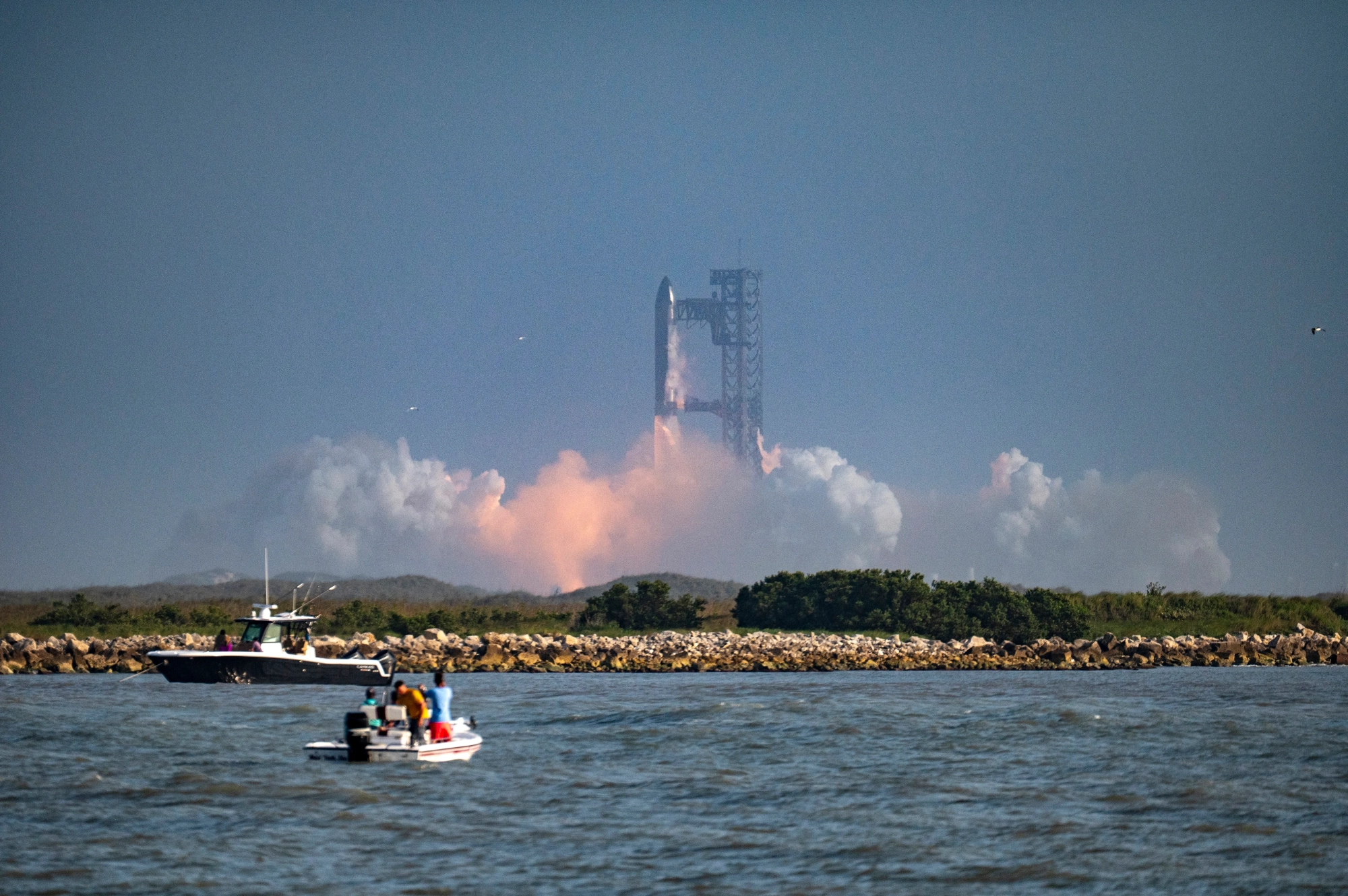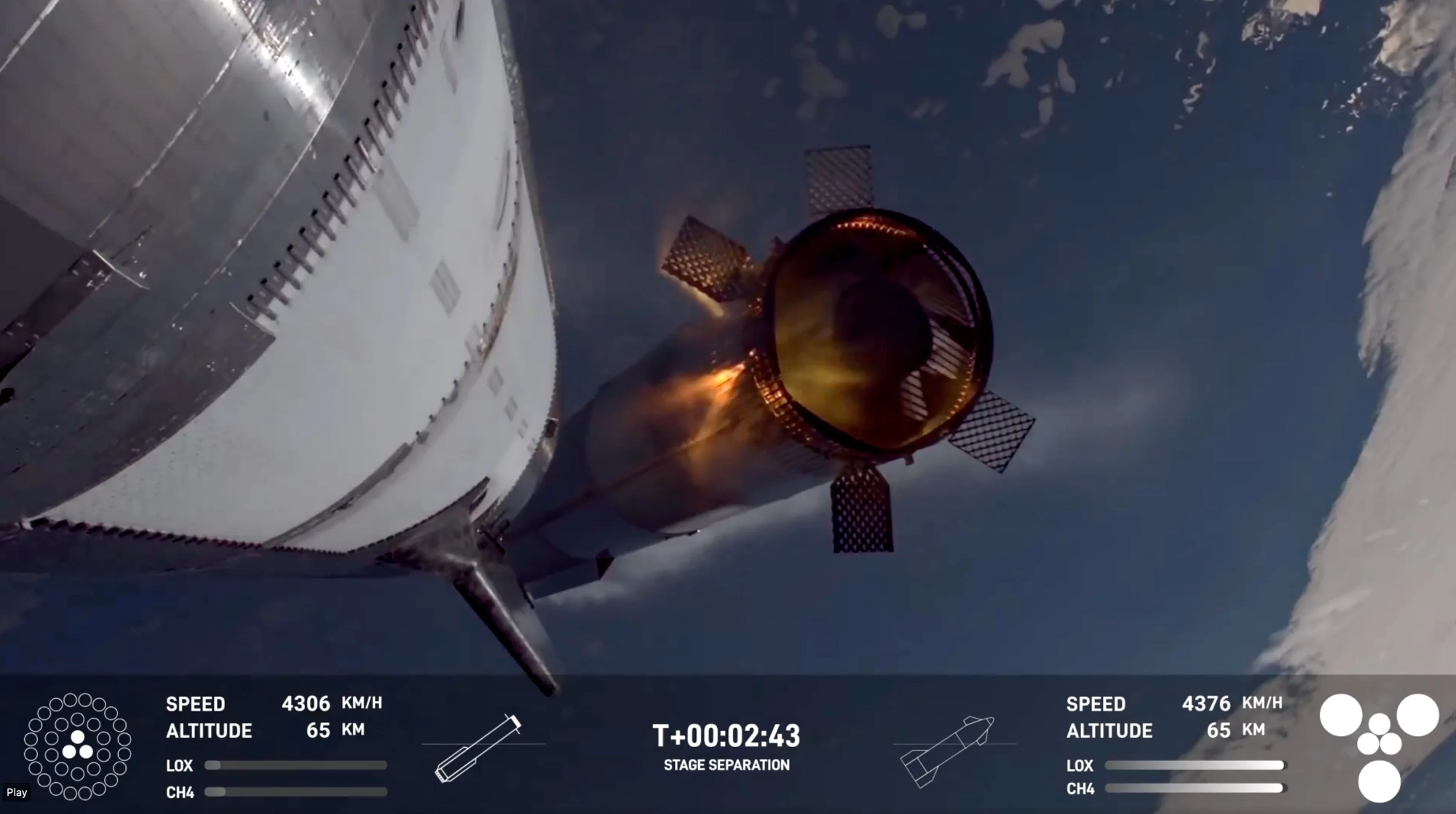Kaboom is not the sound you want a rocket ship to make, as a rule. Yet thats the problem facing the private aerospace company SpaceX and its leader, Elon Musk. Instead of going to space, their newest rocket ship keeps going kaboom.
The last three flights of Starship, a two-stage, 400-foot tall behemoth, ended in fiery disasterwhat Musk has sometimes jokingly called a rapid unplanned disassembly. In January and again in March the launch vehicles Super Heavy booster stage made it back to a massive, pincer-equipped gantry, but Starships upper stage didnt. In May the booster exploded just before splashdown, and Starship broke up spectacularly in the atmosphere, raining debris that commercial aircraft had to dodge. As a bonus, in June the upper stage detonated on the launchpad while Starship was getting fueled for a test firing of its engines. The tally for 2025 thus far is: explosions, four; SpaceX, zero.
Today Starships Super Heavy booster and upper stage are on the launchpad yet again. The 10th test flight is scheduled for liftoff on Sunday, circa 7:30 P.M. EDT, from SpaceXs Starbase launch site in South Texas. If all goes to plan, the booster will use its 33 rocket engines to push the whole shebang to the edge of space, then drop off, somersault, execute a boost-back burn and descend to a soft splashdown in the Gulf of Mexico. Meanwhile Starships upper stage should be firing its rockets to reach orbit, where it will deploy some cargo before flying itself back down through the atmosphere to its own splashdown about an hour and 15 minutes after launch. Excitement guaranteed, a SpaceX announcement promises.
But theres excitement and theres excitement. Look, going to space is hard. Its even harder to do in the way SpaceX is attempting. Its one of the biggest rockets ever. Its, for sure, the biggest rocket that has attempted reuse, says Jonathan McDowell, an astrophysicist at the Center for Astrophysics | Harvard & Smithsonian, who tracks space launches in his spare time. Developing a vehicle this big and launching it repeatedly aint easy.
Starship isnt just an oligarchs folly. Its a launch system meant to revolutionize spaceflight by flying cargo and crews to orbit at a cost thats almost too cheap to meter. Its supposed to take NASA astronauts back to the moon and human settlers to Mars. And it represents the kind of gleaming, hardware-forward future that Silicon Valleys techno-optimists are always promising. Starship is the linchpin of a lot of plans and schemes.
Over the past few months, SpaceX has acknowledged which pieces of the ship broke with each flight but hasnt gone into any great detail about why. The company didnt return requests for comment from Scientific American. But SpaceXs very online rocket-spotting fansand the half-dozen aerospace engineers I talked tohave been willing to speculate what the problems might be. Mostly, they believe the company has some brilliant people who stand every chance of solving them. But they also wonder what will happen if SpaceX cant figure out whats wrongor, even worse, if some fundamental engineering issue means the idea of a reusable, reliable, workhorse spaceship stays confined to science fiction.

A Starship Super Heavy booster returns to the launchpad during a test flight from SpaceXs Starbase facility in South Texas on January 16, 2025. The Starship upper stage exploded and was lost during the flight.
Though SpaceX characterizes this differently, Starship had essentially the same types of mishap in all three of the most recent flightsleaks, fires and explosions in the fuel system. On flight seven, there was a flash and then a fire in the unpressurized attic below the bottom of Starships liquid oxygen tank. On flight eight, that happened near one of the rocket engines. On flight nine, fuel leaked into the nose cone.
That fuel, and the plumbing to move it around, might be the problem. Its a mix of liquid methane and liquid oxygena volatile cryogenic cocktail thats still, by rocket science standards, experimental. To stay liquid, methane has to be below 259 degrees Fahrenheit (162 degrees Celsius), and oxygen has to be even colderbelow 297 degrees F (183 degrees C). That means a lot of mechanical effort to keep it cold, to move it around on the ground and on the vehicle and to accommodate it as it shifts from liquid to gas and gets lit on fire. Going back and forth from supercold to hot is called thermal cycling; without careful design and maintenance, almost anything under those conditions will break.
In a Muskian science-fiction future, thats all worth it. Cryogenic fuel is a pain in the asteroid, but it has more oomph per pound as go juicewhat engineers call specific impulse. And fuels like methane offer the tantalizing possibility that they could be harvested in situ on another worldthat they could be synthesized from carbon dioxide and frozen water in Martian regolith or, say, slurped up from the roiling methane seas of Titan. That makes living off the land in space seem feasible, even though nobody really knows how to do it yet. Methane is a new rocket propellant for space launch, so were still learning how to do the methane plumbing. The fact that theyve had leaks, the fact that theyve had overheating, doesnt really surprise me, McDowell says. Its a different-sized molecule, bigger than liquid hydrogen but smaller than kerosene, so it leaks differently in different circumstances. Its chemistry is different.
But the cryogenic chemistry here might be less relevant than cold mathematics. Anything going to space has to carry its own fuel, but that fuel itself has mass. Thats the tyranny of the rocket equation, says Hassan Saad Ifti, an aerospace engineer at Texas A&M University, referring to the calculation that vexes every would-be space jockey. You need to carry more to deliver what you want, but more fuel means more fuel for the fuel.
Thats why rockets often have stages or external boosters: when they run out of fuel, you drop those components so that the rockets will have less mass to lift. Musks ambitious goal is for Starship to carry between 110 and 165 tons of payload to orbitfive times what a NASA space shuttle could handle, by way of comparison. But to make that work, the vehicle itselfthe dry mass, without propellant, rocket engines and all the plumbinghas to be extraordinarily light. SpaceX is aiming for a structural ratiothe dry mass divided by the sum of the dry mass and the propellantof 0.05 for both stages. Most typical rocket designs, that ratio is around 0.1, says John Dec, an aerospace engineer at the Georgia Institute of Technology. In other words, Starship is on a pretty extreme weight-loss regime.
Some observers and engineers speculate that diet might be the problem. After the failure on flight seven, SpaceXs official blog reported that the cause of the leaks and fire was a harmonic response several times stronger than had been seen during testing, which led to increased stress on hardware in the propulsion system. That is, some of Starships hardware shook itself apart.
Dec was previously at NASA, and his specialty there was entry descentbringing space probes down to the surface of Mars. Its one of aerospace engineerings hardest challenges. For one thing, the atmosphere gets thicker as you get closer to a planets surface. So the force of drag on a descending vehicle changes depending on both the density of the air and the speed of the vehicle; drag becomes, in the language of engineering, a dynamic load. If dynamic loads are changing fast enough, they can cause the vehicle to start to vibrate, Dec says.
Thank you for signing up!
Check out our other newsletters
Vibrate all that complicated cryogenic plumbing too much, and very bad things happen. After flight seven, SpaceX hardened fuel lines to the engines and added vents and a nitrogen-gas purge system to the attic where the leaks happened to deal with the possibility of fires. After flight eight, SpaceX insisted that the problems that Starship faced were completely differentbut bloggers and Redditors passed around a purported leak from an insider saying that the root issue hadnt changed. It was harmonic oscillationsvibrations, again, this time busting methane lines running through the liquid oxygen tank again: When the tank was full of liquid oxygen, it dampened the vibrations. But as the tank emptied, the shaking got worse.
Starships two stages have to structurally support nearly 11 million pounds of fuel; the upper stage is meant to carry as much as 330,000 pounds of payload. So the vessel itself has to be as light as possibleyet still withstand the buffeting forces of launch and reentry. So far, it has not. Theyve designed their structure light enough to perform when the rocket ignites and wants to fly, but maybeand this is speculationwhen theyre loading the fuel, thats causing cracking, Dec says. When a structure is cooled, it shrinks. If its rigid and cant move, thats going to cause a stress, and its going to break.
A couple other pieces of evidence fit this theory. One reason the booster may have survived flights that the upper stage did not is that the booster doesnt go all the way to space, and it comes back to the ground at only about 4,600 miles per hour. Starships upper stage goes all the way to orbit and reaches 17,500 mph. Thats a lot of kinetic energy to get rid of on reentryusually as heat. This is the physical constraint, Ifti says. We cant get away from it. We have to manage this energy being generated through heating.
An early version of Starship tried to bleed off that kinetic energy with a kind of aerodynamic belly flop that ended in a catastrophic loss of control. Now the vehicle uses its control surfaces and rockets to slow its descent and relies on heat-resistant tiles (which, of course, add weight). One persistent critic of SpaceX, Will Lockett, has argued that Starship simply must use more propellant than its builders expected for its return flights, adding even more weight. This puts incredible pressure on SpaceX to save weight anywhere they possibly can, Lockett wrote in his newsletter in March. SpaceX is having to make the rockets too light, resulting in them being fragile, meaning that just the vibrations from operation with a fraction of its expected payload would be enough to destroy the rocket.
Kaboom.
Maybe this build-test-destroy-rebuild cycle is what youd expect from a cutting-edge company like SpaceX, which owes much of its astonishing success to iterating like a software start-up. The version of Super Heavy thats set to launch on Sunday has some major design changes, increasing the size and strength of the winglets called grid fins but reducing their number from four to three and aiming for a more controlled, higher angle-of-attack descent. Starships upper stage will also test several new kinds of tiles to protect against the ferocious heat of reentry. This is what coders call agile.
In practice, though, this Silicon Valleystyle approach forces SpaceX to play a very expensive game of Whac-A-Mole. The way I read what Elons trying to do, wow, is it complicated. And when you deal with a very complicated device, theres multiple modes of failure, says Joseph Powers, an aerospace engineer at the University of Notre Dame and editor in chief of the Journal of Propulsion and Power. With a rocket, that almost always results in detonation.
Each failure is supposed to be an opportunity to learn to avoid disaster the next time. Theyre facing challenges, but I dont see any showstoppers, McDowell says. I dont want to minimize the problems theyre having. It is embarrassing for SpaceX, and they do have to fix these things, but they are making progress.
So theres an easy solution: reduce the weight of the payload Starship can carry and charge more per pound. But even if SpaceX and its customers can absorb the higher price, not all of Starships planned missions can necessarily wait for a more reliable spacecraft. NASAs Artemis III is supposed to use Starship to land astronauts on the moons south pole in 2027. Thats practically tomorrow, in aerospace time. Plus, even if you didnt already think that ionizing radiation and toxic regolith make Musks dreams for Mars settlement about as likely as finding canals there, a reduction in Starships cargo capacity and rapid reusability would seem to doom the plan. One model for making the trip in three months instead of the usual six or nine requires four cargo Starships and two crew Starships and assumes a total of 45 launchesa mere fraction of the 1,000 Starship launches per year SpaceX foresees.
Even McDowell, whos more sanguine about the tech, acknowledges the possibility that theres something more existential at play. Every time you add a widget to fix something, you increase the mass and decrease the payload capacity, he says. Thats the key question we dont know in the public domain: To what extent are the fixes causing performance losses? Musk and SpaceX share a reputation for bold technological winsthey blew up a lot of Falcon 9 rockets before that vehicle became the ultrareliable, game-changing satellite launcher it is today. But investors and customers wont wait for Starship forever. For a would-be rocket builder, the only thing worse than a kaboom is silence.








